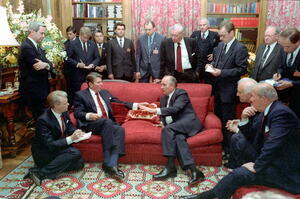The decisive political push that launched ITER
Forty years ago, on 19-21 November 1985, a long-running initiative of international collaboration in the field of fusion energy received a decisive political push. In Geneva, where they were meeting for the first time, US president Ronald Reagan and Secretary General Mikhail Gorbachev advocated in a final joint statement for “the widest practicable development of international cooperation in obtaining this source of energy, which is essentially inexhaustible, for the benefit for all mankind.” Fusion energy was the last item in a long list that ranged from the strategic ("a nuclear war cannot be won and must never be fought") to the trivial ("increased television coverage of sports events"). But it was an item that, in the long term, held the potential to change the course of civilization.
By the time of the Geneva Summit, international collaboration in the field of fusion research was already a well-established practice. As early as the late 1950s, following Nikita Khrushchev’s visit to Harwell, the holy of holies of nuclear research in the United Kingdom, scientists on both sides of the Iron Curtain were sharing results, doubts, and expectations. In 1973, a formalization of these scattered exchanges was attempted. In an almost surreal anticipation of the Geneva Summit of 1985, an American president, Richard Nixon, and a Soviet Secretary General, Leonid Brezhnev, agreed that cooperating in the field of fusion science was a promising way of easing tensions between their two countries.
Out of this shared vision, the first truly international effort to develop a large experimental fusion reactor was born. The INTOR—INternational TOkamak Reactor— project was very close to ITER in its concept but much looser in its organization. An INTOR Steering Group was established, teams from national fusion experiments would gather two to four times a year at the IAEA headquarters in Vienna, but the international venture never reached the actual design phase and “things started cycling,” remember the scientists who participated in the project. In 1987, INTOR was eventually folded into the nascent ITER.
The fusion world in the mid-1980s was fundamentally different from what it had been two decades earlier. International collaboration at the European level had succeeded in actually building and operating a large tokamak—the Joint European Torus (JET), whose construction was launched in 1973—and global research was reaching the point where a much larger, more powerful machine was needed to demonstrate the feasibility of hydrogen fusion.
The project that was incepted at the Geneva Summit added a geopolitical dimension to the technological and scientific expectations of the fusion community. As both Reagan and Gorbachev intended to find a way out of the Cold War tensions, the “widest practicable development of international cooperation” that they advocated for was a perfect “object” to illustrate their determination.
Forty years later new tensions have risen, and few of the “agreements” in the Geneva Summit’s joint final statement have been implemented. Except for the last item on the list: the international effort to harness fusion energy “for the benefit of all mankind.”


